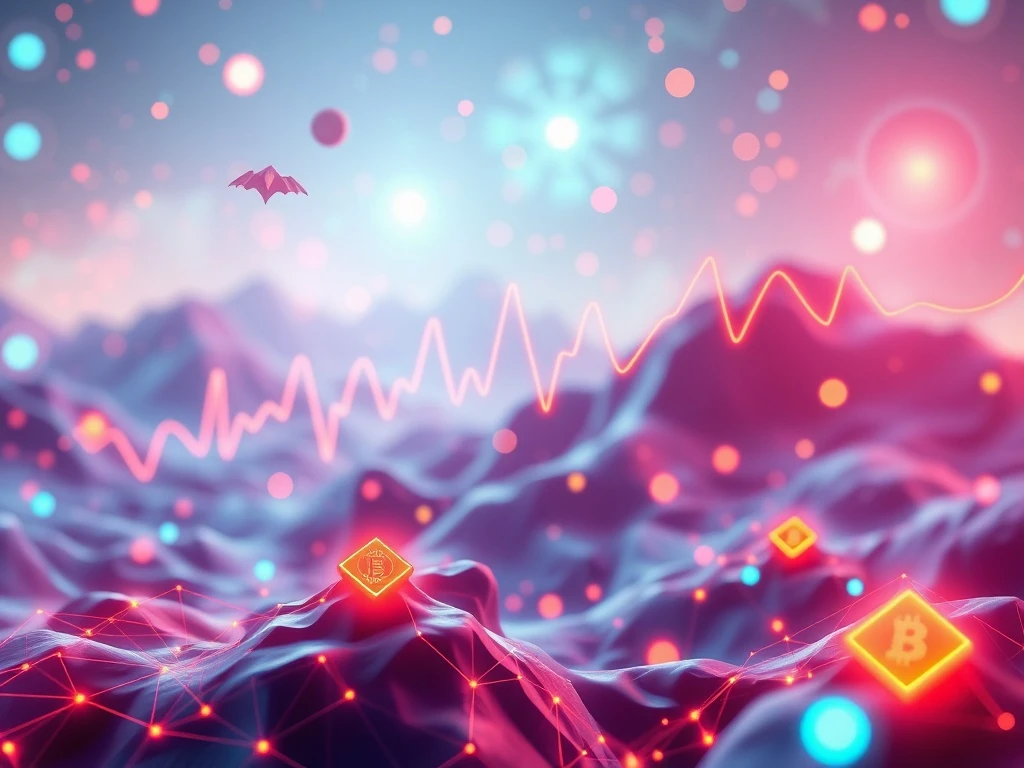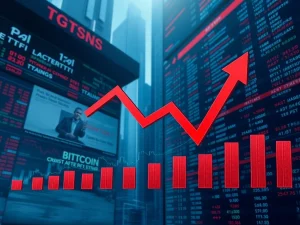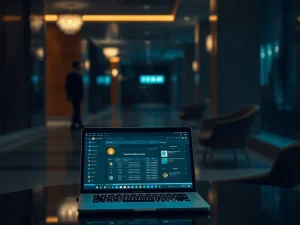Metaverse Roars Back: NFT Sales Soar 27% in August, Igniting Virtual Worlds

The metaverse, once considered by some to be a fleeting trend, shows remarkable signs of life. Recent data reveals a significant uptick in activity, challenging earlier predictions of its demise. This resurgence offers a compelling narrative for anyone interested in the future of digital interaction and asset ownership. Specifically, Metaverse-related NFT sales have seen a substantial increase, signaling renewed user engagement.
Metaverse NFT Sales Spark Renewed Optimism
The digital landscape is shifting, and the metaverse appears to be finding its footing once more. According to a recent report from DappRadar, non-fungible token (NFT) sales within virtual worlds climbed by a remarkable 27% in August. This figure represents a notable increase from the preceding month. Overall, the metaverse recorded $6.5 million in trading volume during August. This volume came from 13,927 individual sales. While slightly down in volume from July, the jump in sales transactions indicates a growing user base. Furthermore, this marks the second consecutive month of heightened activity for virtual platforms. Sara Gherghelas, an analyst at DappRadar, highlighted this positive trend. She suggested that the metaverse is far from dead, with users potentially ‘slowly sneaking back into virtual worlds.’
Understanding the Recent Surge in Virtual Worlds
The metaverse experienced peak interest during 2021 and 2022. Speculation and excitement about its potential drove this initial surge. However, the hype cycle cooled significantly in 2023. Many observers questioned the long-term viability of these digital spaces. Despite this slowdown, the latest figures suggest a turnaround. In July, DappRadar reported $6.7 million in sales from 10,900 transactions. This was a substantial jump from June’s $3.7 million in sales and 12,800 transactions. August’s 27% increase in NFT sales builds on this momentum. It hints that users are indeed returning to prominent platforms like The Sandbox, Mocaverse, Otherside, and Decentraland. However, it is important to note that January still holds the record for the best sales month this year, reaching $7.7 million. April and May led in trading volume, each clocking over 19,000 transactions.
This renewed interest points to several factors:
- Increased Utility: Platforms are offering more engaging experiences.
- Lower Entry Barriers: Access to virtual worlds is becoming simpler.
- Community Building: Stronger communities foster loyalty.
- Infrastructure Development: Underlying technology is improving steadily.
Web3 Platforms Building for the Future
The current focus for leading platforms has shifted dramatically. Analyst Sara Gherghelas notes that developers are prioritizing long-term infrastructure. This strategic pivot aims to create sustainable and robust digital environments. Many Web3 platforms are investing heavily in foundational technologies. They understand that a solid base is crucial for future growth and widespread adoption. This approach contrasts sharply with the earlier focus on rapid expansion driven by speculative interest. Developers are now creating more stable and user-friendly ecosystems. This deliberate building phase ensures greater resilience for the entire metaverse sector.
Key Players and Their Strategic Moves:
Several major players are making significant strides in infrastructure development. Each platform brings unique contributions to the evolving metaverse landscape. Their efforts collectively shape the future of digital interaction and ownership.
- The Sandbox: This metaverse-focused subsidiary of Animoca Brands held its largest Land auction in July. This event showcased continued demand for virtual real estate. The Sandbox focuses on user-generated content and decentralized governance.
- Mocaverse: A Web3 ecosystem and NFT project, Mocaverse is preparing for a major launch. Its Moca Chain testnet is expected this quarter. This development aims to enhance scalability and transaction efficiency within its ecosystem.
- Otherside: Developed by Yuga Labs, Otherside released AI-powered world-building tools in August. These tools empower creators to design more immersive and dynamic virtual experiences. This integration of AI represents a significant leap forward in metaverse development.
- Decentraland: This browser-based 3D virtual world announced a major engine upgrade. Such upgrades improve performance, graphics, and overall user experience. Decentraland continues to be a pioneer in decentralized virtual land ownership.
- HYTOPIA: A Web3 gaming platform, HYTOPIA replaced its $TOPIA token with the new $HYBUX token. The team also expanded its creator fund. These changes aim to incentivize content creation and foster a vibrant in-game economy.
Gherghelas emphasized that while trading volumes remain modest, the shift towards long-term infrastructure, identity solutions, and creator tools is critical. This focus promises a more stable and feature-rich metaverse experience for users.
The Growing Ecosystem of Blockchain Gaming
The intersection of the metaverse and gaming is particularly dynamic. Blockchain gaming is a powerful driver for metaverse adoption and NFT sales. These games leverage blockchain technology to provide true digital ownership of in-game assets. Players can buy, sell, and trade NFTs representing characters, weapons, skins, and virtual land. This model fundamentally changes how players interact with games. It moves from a rental model to one of genuine ownership. The rise in metaverse activity directly correlates with innovations in this sector. Gamers are increasingly drawn to experiences where their time and investment yield tangible digital assets.
NFTs as the Backbone of Digital Economies:
NFTs play a crucial role in these evolving digital economies. They represent unique items within virtual worlds and games. Their scarcity and verifiable ownership are key features. Consequently, the increase in NFT sales within the metaverse indicates a growing trust and investment in these digital assets. Players are not just participating; they are investing in their virtual identities and possessions. This trend supports the long-term vision of a user-owned internet, often referred to as Web3.
Key aspects of NFTs in blockchain gaming include:
- True Ownership: Players own their digital assets outright.
- Interoperability: Some NFTs can be used across different games or platforms.
- Monetization Opportunities: Players can earn real-world value from their in-game activities.
- Community Engagement: NFTs often grant access to exclusive communities or events.
New Entrants and Expanding Metaverse Horizons
The metaverse continues to attract diverse players, extending beyond traditional crypto native companies. This expansion highlights the growing mainstream recognition of virtual worlds. New ventures and established brands are exploring ways to integrate into this evolving digital frontier. Their participation adds credibility and resources to the space. It also brings fresh perspectives and innovative applications for metaverse technology. These new entrants signal a broader acceptance and belief in the metaverse’s future.
Notable New Initiatives:
The ongoing development of the metaverse is not limited to existing platforms. New companies are actively planning their entry. This includes both established names and innovative startups. Their diverse backgrounds promise a rich tapestry of future virtual experiences.
- Infinite Reality and Napster: Artificial intelligence startup Infinite Reality acquired the iconic music streaming service Napster in March. The company plans to integrate a music-focused metaverse. This initiative aims to revolutionize how artists and fans interact in digital spaces.
- DTTM Operations: Donald Trump-owned DTTM Operations filed for trademarks in February. These filings relate to a metaverse and NFT marketplace built around the former US President’s brand. This move demonstrates how various sectors are exploring the potential of virtual environments.
These examples illustrate the widening appeal and potential applications of metaverse technology. They show that the concept is evolving beyond its initial gaming and art-centric roots. Industries like music, entertainment, and even politics are recognizing the strategic value of virtual presence.
Navigating the Future of Digital Assets and Virtual Worlds
The recent surge in NFT sales within the Metaverse paints a picture of cautious optimism. While the sector is not yet experiencing the explosive growth of its early days, the consistent activity suggests a maturing market. The focus has shifted from speculative hype to practical utility and robust infrastructure. This indicates a healthier, more sustainable growth trajectory. As Web3 platforms continue to innovate, the experiences within these digital realms will become richer and more compelling. Consequently, this will likely attract an even broader audience. The integration of AI, enhanced creator tools, and improved performance will play a vital role in this evolution. Furthermore, the increasing prominence of Blockchain gaming ensures a steady stream of engaging content and valuable digital assets. This ongoing development solidifies the metaverse’s position as a key component of the internet’s future.
Challenges and Opportunities Ahead:
Despite the positive indicators, challenges remain. Scalability, interoperability between different virtual worlds, and user onboarding complexities still need addressing. However, these challenges also present significant opportunities for innovation. Companies that successfully navigate these hurdles will likely emerge as leaders in the next phase of digital evolution. The commitment to building long-term value, rather than chasing short-term gains, will ultimately determine the success of these ambitious projects. The metaverse is not just a destination; it is an ongoing journey of technological and social innovation.
In conclusion, the metaverse is far from dead. It is evolving, adapting, and showing clear signs of renewed vigor. The 27% jump in NFT sales in August is a compelling indicator of this trend. It reflects a growing user base returning to immersive digital experiences. As Web3 platforms continue to build out their infrastructure and blockchain gaming thrives, the future of virtual worlds looks increasingly promising. This sustained activity underscores a fundamental shift towards more meaningful and sustainable digital engagement. The metaverse, therefore, truly still has a heartbeat, beating stronger with each passing month.







